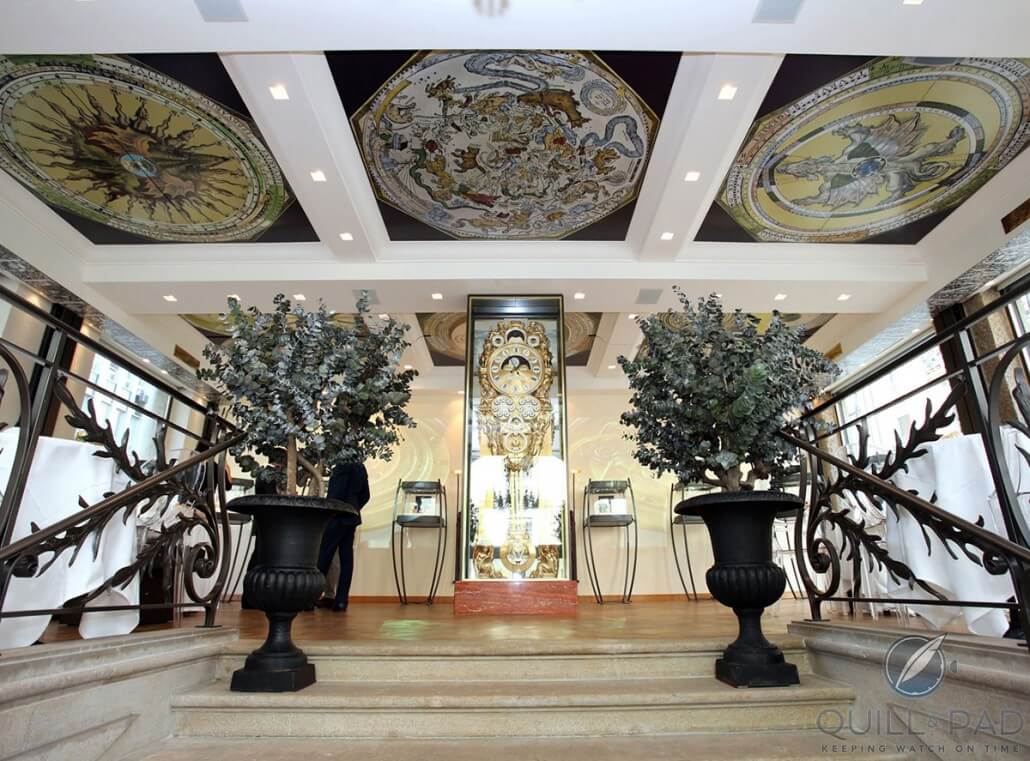If you’ve never been to visit François-Paul Journe’s atelier in the heart of Geneva, now would be a very good time to do so.
Aside from the astounding watches you will likely encounter on display, backlit by enormous bay windows allowing the space to bathe in natural light, there are a great number of other interesting objects a fan of good watchmaking shouldn’t miss.
One of them hits you in the face as soon as you walk through the door: an astounding nine-foot-tall astronomical clock made by Constantin Louis Detouche, which won a gold medal in 1855 at the Exposition Universelle (International Exhibition) of Paris.

Front and center at the F.P. Journe showroom in Geneva: the Detouche astronomical clock underneath astrolabe paintings on the ceiling inspired by the ancient astronomer Apianus; the new library now sits against the back wall
Journe has said that it took more than a decade to acquire the clock, while the Musée International d’Horlogerie (MIH) in La Chaux-de-Fonds needed another three years to fully restore it to its former glory. It displays the days, weeks, months, and year as well as the path of the ascending sun among a plethora of indications and displays.
The F. P. Journe atelier was a gas lamp factory in former days, and its extensive natural light illuminates the decorative ceiling frescoes, which are replicas of designs dating back to 1550 depicting the operations of an astrolabe that once graced the abode of astronomer Apianus. As one’s gaze moves across the ceiling, it invariably comes to rest on the black Baccarat chandelier emerging from between the frescoes just above the Detouche clock (but not visible in the photo above).
And the observer is once again jolted back to the reality of modern-day Geneva.
Now something else historic comes Journe’s way: nearly one thousand books, manuscripts, letters, and catalogs once belonging to the extensive horological library of departed historical expert and close confidante Jean-Claude Sabrier.
Jean-Claude Sabrier
Sabrier passed away at the age of 76 in November 2014. A Swiss horological expert and distinguished historian, Sabrier had amassed an intensely detailed horological knowledge (and library) during a period in time when such expertise was practically non-existent.

A few of the historic horological books in the F.P. Journe/Sabrier library at the Journe atelier in Geneva
Sabrier and Journe first met about 40 years ago in Paris.
The two men shared a number of specialized interests within the world of horology. In fact, the 2006 book Steel Time Sabrier co-wrote with Georges Rigot showcases to a collection of 220 gunmetal pocket watches, some of which Sabrier had collected or was involved in looking out. When the extensive book was released, not very coincidentally in the same year that Journe officially introduced his stainless steel-encased Sonnerie Souveraine (see The Sonnerie Souveraine By F.P. Journe: A Legend In Its Own Time), a great majority of these watches were also put on display in the Journe workshop – at more or less the same place the books now reside.
Sabrier received a Gaïa Award in 1977 for his own contributions to historical research in horology and later became a jury member of the prestigious MIH-organized prize.

From the library of Jean-Claude Sabrier at F.P. Journe’s workshop: ‘L’Art de Regler et Conduire les Pendules’ by Ferdinand Berthoud

From the library of Jean-Claude Sabrier at F.P. Journe’s workshop: Ferdinand Berthoud’s signature on a document
Sabrier’s library
Sabrier and Journe were bound by a profound friendship, so much is obvious. For this reason, when Sabrier’s library comprising an extensive collection of written horological masterpieces, auction catalogs, and rare historical letters and workbook excerpts, went up for auction on June 15, 2015 in Paris, Journe acquired all 273 lots (almost one thousand books in total) for a price of 760,000 Swiss francs.
Putting his great respect for Sabrier out on display for all to see, Journe now perpetuates his memory by exhibiting the historical library centrally in his workshop’s exhibition space within a custom-built set of wooden bookshelves.
A testimony to the depth, extent, and pertinence of Sabrier’s research on the lives and achievements of the world’s greatest master watchmakers, the library contains genuine treasure written by greats from the history of horology such as Ferdinand Berthoud, Pierre Le Roy, Antide Janvier, Abraham Louis Breguet, and Thomas Mudge among others.
It is certainly difficult to fully appreciate the extent of this impressive collection just by reading about it. Do make it a point to visit F.P. Journe’s beautiful workshop in Geneva and see it for yourself.
























































Trackbacks & Pingbacks
[…] uma proposta Quill & Pad que vale a pena descobrir: a juntar ao elenco de peças de extrema importância que François-Paul […]
Leave a Reply
Want to join the discussion?Feel free to contribute!